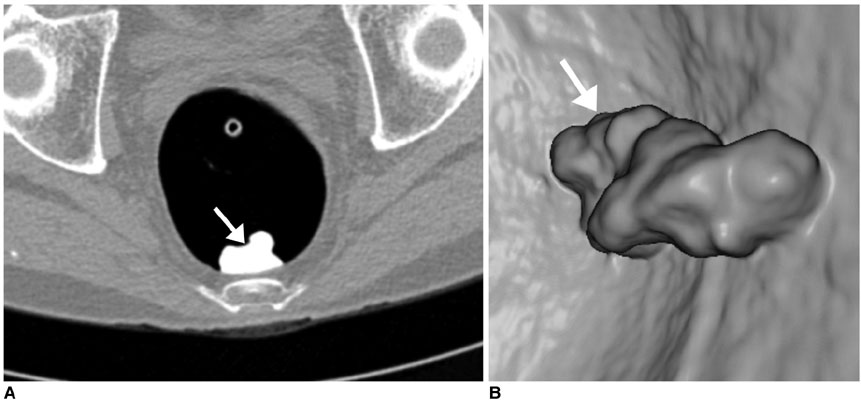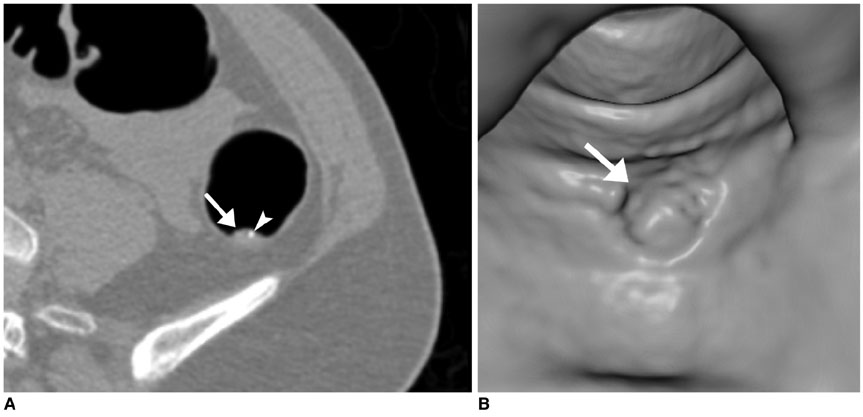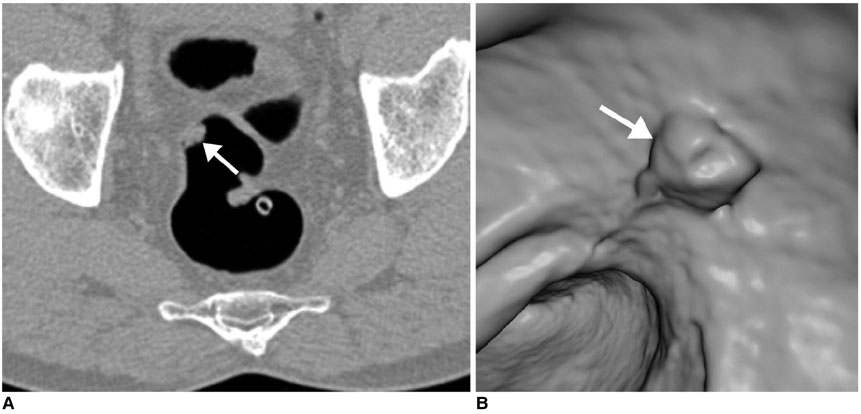Korean J Radiol.
2009 Feb;10(1):25-33. 10.3348/kjr.2009.10.1.25.
Efficacy of Barium-Based Fecal Tagging for CT Colonography: a Comparison between the Use of High and Low Density Barium Suspensions in a Korean Population - a Preliminary Study
- Affiliations
-
- 1Department of Radiology and Research Institute of Radiology and Internal Medicine, University of Ulsan College of Medicine, Asan Medical Center, Seoul, Korea. seongho@amc.seoul.kr
- 2Department of Radiology, Asan Medical Center, Seoul, Korea.
- 3Department of Radiology, David Geffen School of Medicine, University of California Los Angeles, Los Angeles, CA, USA.
- 4National Cancer Center, Gyeonggi-do, Korea.
- KMID: 1088675
- DOI: http://doi.org/10.3348/kjr.2009.10.1.25
Abstract
OBJECTIVE
This preliminarily study was designed to determine and to compare the efficacy of two commercially available barium-based fecal tagging agents for CT colonography (CTC) (high-density [40% w/v] and low-density [4.6% w/v] barium suspensions) in a population in Korea. MATERIALS AND METHODS: In a population with an identified with an average-risk for colorectal cancer, 15 adults were administered three doses of 20 ml 40% w/v barium for fecal tagging (group I) and 15 adults were administered three doses of 200 ml 4.6% w/v barium (group II) for fecal tagging. Excluding five patients in group I and one patient in group II that left the study, ten patients in group I and 14 patients in group II were finally included in the analysis. Two experienced readers evaluated the CTC images in consensus regarding the degree of tagging of stool pieces 6 mm or larger. Stool pieces were confirmed with the use of standardized CTC criteria or the absence of matched lesions as seen on colonoscopy. The rates of complete fecal tagging were analyzed on a per-lesion and a per-segment basis and were compared between the patients in the two groups. RESULTS: Per-lesion rates of complete fecal tagging were 52% (22 of 42; 95% CI, 37.7-66.6%) in group I and 78% (28 of 36; 95% CI, 61.7-88.5%) in group II. The difference between the two groups did not reach statistical significance (p = 0.285). The per-segment rates of complete tagging were 33% (6 of 18; 95% CI, 16.1%-56.4%) in group I and 60% (9 of 15; 95% CI, 35.7%-80.3%) in group II; again, the difference between the two groups did not reach statistical significance (p = 0.171). CONCLUSION: Barium-based fecal tagging using both the 40% w/v and the 4.6% w/v barium suspensions showed moderate tagging efficacy. The preliminary comparison did not demonstrate a statistically significant difference in the tagging efficacy between the use of the two tagging agents, despite the tendency toward better tagging with the use of the 4.6% w/v barium suspension.
Keyword
MeSH Terms
Figure
Reference
-
1. Park SH, Yee J, Kim SH, Kim YH. Fundamental elements for successful performance of CT colonography (virtual colonoscopy). Korean J Radiol. 2007. 8:264–275.2. Lefere PA, Gryspeerdt SS, Dewyspelaere J, Baekelandt M, Van Holsbeeck BG. Dietary fecal tagging as a cleansing method before CT colonography: initial results polyp detection and patient acceptance. Radiology. 2002. 224:393–403.3. Beebe TJ, Johnson CD, Stoner SM, Anderson KJ, Limburg PJ. Assessing attitudes toward laxative preparation in colorectal cancer screening and effects on future testing: potential receptivity to computed tomographic colonography. Mayo Clin Proc. 2007. 82:666–671.4. Ristvedt SL, McFarland EG, Weinstock LB, Thyssen EP. Patient preferences for CT colonography, conventional colonoscopy, and bowel preparation. Am J Gastroenterol. 2003. 98:578–585.5. Bielen D, Thomeer M, Vanbeckevoort D, Kiss G, Maes F, Marchal G, et al. Dry preparation for virtual CT colonography with fecal tagging using water-soluble contrast medium: initial results. Eur Radiol. 2003. 13:453–458.6. Callstrom MR, Johnson CD, Fletcher JG, Reed JE, Ahlquist DA, Harmsen WS, et al. CT colonography without cathartic preparation: feasibility study. Radiology. 2001. 219:693–698.7. Dachman AH, Dawson DO, Lefere P, Yoshida H, Khan NU, Cipriani N, et al. Comparison of routine and unprepped CT colonography augmented by low fiber diet and stool tagging: A pilot study. Abdom Imaging. 2007. 32:96–104.8. Gryspeerdt S, Lefere P, Herman M, Deman R, Rutgeerts L, Ghillebert G, et al. CT colonography with fecal tagging after incomplete colonoscopy. Eur Radiol. 2005. 15:1192–1202.9. Iannaccone R, Laghi A, Catalano C, Mangiapane F, Lamazza A, Schillaci A, et al. Computed tomographic colonography without cathartic preparation for the detection of colorectal polyps. Gastroenterology. 2004. 127:1300–1311.10. Johnson CD, Manduca A, Fletcher JG, MacCarty RL, Carston MJ, Harmsen WS, et al. Noncathartic CT colonography with stool tagging: performance with and without electronic stool subtraction. AJR Am J Roentgenol. 2008. 190:361–366.11. Johnson KT, Carston MJ, Wentz RJ, Manduca A, Anderson SM, Johnson CD. Development of a cathartic-free colorectal cancer screening test using virtual colonoscopy: a feasibility study. AJR Am J Roentgenol. 2007. 188:W29–W36.12. Lefere P, Gryspeerdt S, Baekelandt M, Van Holsbeeck B. Laxative-free CT colonography. AJR Am J Roentgenol. 2004. 183:945–948.13. Lefere P, Gryspeerdt S, Marrannes J, Baekelandt M, Van Holsbeeck B. CT colonography after fecal tagging with a reduced cathartic cleansing and a reduced volume of barium. AJR Am J Roentgenol. 2005. 184:1836–1842.14. Pickhardt PJ, Choi JR, Hwang I, Butler JA, Puckett ML, Hildebrandt HA, et al. Computed tomographic virtual colonoscopy to screen for colorectal neoplasia in asymptomatic adults. N Engl J Med. 2003. 349:2191–2200.15. An S, Lee KH, Kim YH, Park SH, Kim HY, Kim SH, et al. Screening CT colonography in an asymptomatic average-risk Asian population: a 2-year experience in a single institution. AJR Am J Roentgenol. 2008. 191:W100–W106.16. Yun JY, Ro HJ, Park JB, Choi JB, Chung JE, Kim YJ, et al. Diagnostic performance of CT colonography for the detection of colorectal polyps. Korean J Radiol. 2007. 8:484–491.17. Dictionary.Com. Accessed February 21, 2008. http://dictionary.reference.com/browse/Kimchi.htm.18. Dachman AH, Zalis ME. Quality and consistency in CT colonography and research reporting. Radiology. 2004. 230:319–323.19. Taylor SA, Halligan S, Goh V, Morley S, Bassett P, Atkin W, et al. Optimizing colonic distention for multi-detector row CT colonography: effect of hyoscine butylbromide and rectal balloon catheter. Radiology. 2003. 229:99–108.20. Pickhardt PJ, Lee AD, McFarland EG, Taylor AJ. Linear polyp measurement at CT colonography: in vitro and in vivo comparison of two-dimensional and three-dimensional displays. Radiology. 2005. 236:872–878.21. Lee SS, Park SH, Choi EK, Kim SY, Kim MJ, Lee KH, et al. Colorectal polyps on portal phase contrast-enhanced CT colonography: lesion attenuation and distinction from tagged feces. AJR Am J Roentgenol. 2007. 189:35–40.22. Taylor SA, Slater A, Burling DN, Tam E, Greenhalgh R, Gartner L, et al. CT colonography: optimisation, diagnostic performance and patient acceptability of reduced-laxative regimens using barium-based faecal tagging. Eur Radiol. 2008. 18:32–42.23. Best preps are tailored to VC reading method. AuntMinnie.com. 2005. 11. 16. Accessed August 6, 2007. http://www.auntminnie.com.24. Park SH, Lee SS, Kim JK, Kim MJ, Kim HJ, Kim SY, et al. Volume rendering with color coding of tagged stool during endoluminal fly-through CT colonography: effect on reading efficiency. Radiology. 2008. 248:1018–1027.25. Pickhardt PJ. Screening CT colonography: how I do it. AJR Am J Roentgenol. 2007. 189:290–298.26. Yoshida H, Nappi J. CAD in CT colonography without and with oral contrast agents: progress and challenges. Comput Med Imaging Graph. 2007. 31:267–284.27. New Zealand medicines and medical devices safety authority. Medsafe website. Accessed August 10, 2007. http://www.medsafe.govt.nz.
- Full Text Links
- Actions
-
Cited
- CITED
-
- Close
- Share
- Similar articles
-
- CT Colonography
- Virtual CT Colonoscopy and Virtual CT Barium Enema using Multidetector-row CT
- Acute Respiratory Failure Caused by Aspiration of High Density Barium: A Case Report
- Comparison of pressure between barium reduction and air reduction of the intussusception in children
- Strategy for early detection of colon cancer




